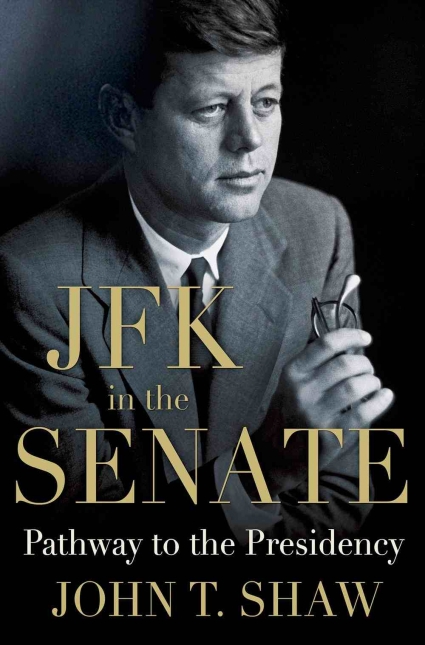JFK in the Senate: Pathway to the Presidency
- By John T. Shaw
- Palgrave McMillan
- 256 pp.
- Reviewed by Claude R. Marx
- October 28, 2013
An engaging, enjoyable account of how John F. Kennedy used his time on Capitol Hill to position himself for even higher office.

The pre- and post-presidential careers of our nation’s chief executives do not generally get a great deal of literary attention. Because much of the focus of political and historical analysis is focused on the occupants of the Oval Office, the other parts of presidential lives are sometimes relegated to the margins.
Some presidents had truly notable careers before or after their times in office. These include George Washington, John Adams, Thomas Jefferson, James Madison, James Monroe, John Quincy Adams, Ulysses S. Grant, William Howard Taft, Dwight Eisenhower and Lyndon Johnson. The non-presidential careers of most chief executives, however, are considerably less memorable and important.
John F. Kennedy’s tenure in the House and Senate falls into this category. Nevertheless, JFK in the Senate: Pathway to the Presidency is an engaging and at times enjoyable account of how Kennedy used his time on Capitol Hill to position himself to become president.
Kennedy was in no sense a legislative heavyweight and John T. Shaw, the senior congressional correspondent for Market News Service, does not try to make him out to be one. But by focusing on a few legislative initiatives, Shaw succeeds in showing how Kennedy developed as a national political figure.
During his time as a senator, Kennedy focused on issues such as labor reform and foreign policy as a way to make a name for himself. He came down hard on the corrupt practices of certain labor unions, notably the Teamsters. But Kennedy did not just berate union leaders in front of the television cameras during committee hearings. The junior senator from Massachusetts got his hands dirty and wrote and shepherded through legislation to reform certain practices, even though the final bill was weaker than he would have liked.
Shaw concludes that Kennedy’s efforts “demonstrated his ability to master the art of political theater” and “his legislative skills were solid, but not overwhelming.”
While Kennedy was able to do well with both style and substance, sadly the same cannot be said of Shaw.
To be sure, the book is quite informative and synthesizes a great deal of information from disparate sources. Unfortunately the prose is turgid and there are few memorable phrases when describing either the policy discussions or personalities that were the hallmarks of the Senate in the 1950s.
Shaw’s descriptions of the legislative debates would be at home in a political science or history textbook. On the personality front, readers don’t come away with vivid enough portraits of Senate giants such as LBJ and Robert Taft. Fortunately, those lawmakers are the subjects of great biographies. Books by Robert Caro, Robert Dallek and Rowland Evans and Robert Novak do justice to Johnson. Books by James Patterson (not the novelist) and William White do the same for Taft.
The best chapters are those when Shaw takes readers behind the scenes in the writing of Profiles in Courage and the selection of the nation’s best senators.
Kennedy used his book, which won the Pulitzer Prize (after heavy lobbying by the author’s friends and family), to demonstrate his knowledge of history and overall gravitas. Its portraits of eight senators whom JFK admired raised his national profile and helped dispel his image as a lightweight. Shaw tells us that whether Kennedy wrote the book (as opposed to editing the work of others) is still the subject of debate. He quotes Kennedy aide Theodore Sorensen’s recollection in his 2008 memoir, Counselor, that the concept of the book was JFK’s and he “wrote or rewrote most of the chapters.’’
But Shaw omits the complete Sorensen passage from that book, which seems to indicate that the question of authorship is more complicated:
“Is the author the person who did much of the research and helped choose the words in many of its sentences, or is the author the person who decided the substance, structure and themes of the book; read and revised each draft; inspired, constructed, and improved the work? Like JFK’s speeches, Profiles in Courage was a collaboration …” Sorensen writes.
Shaw’s discussion of Kennedy’s chairmanship of a committee tasked to pick the five greatest senators ever sheds light on JFK’s leadership style — authoritative but not dictatorial — and his love of historical research. While the chapter has enough detail to satisfy even the most passionate of history nerds, it also reinforces the image of Kennedy as one who didn’t tackle a lot of controversial issues while a lawmaker. The senators that the panel picked were John C. Calhoun, Henry Clay, Robert LaFollette Sr., Robert Taft and Daniel Webster.
The chapter about Kennedy’s 1960 campaign for the White House is insightful and a helpful reminder of how JFK and then-Vice President Richard Nixon helped transform 20th-century electoral politics and move it into the television age. It will also prompt some to read or reread Theodore White’s The Making of the President 1960, which transformed political journalism by taking readers behind the scenes of the campaign and humanized the electoral process.
This November’s 50th anniversary of the Kennedy assassination will prompt many reassessments and reviews of JFK’s presidency. Readers will have a better understanding of those 1,000 days if they know more about his legislative career. Those wanting to fill in the gaps in their knowledge gap of this area will find JFK in the Senate: Pathway to the Presidency a helpful way to accomplish that.
Claude R. Marx is an award-winning journalist who is writing a biography of William Howard Taft.

